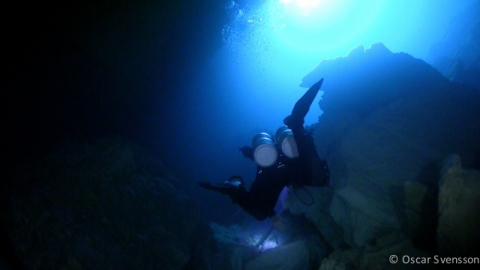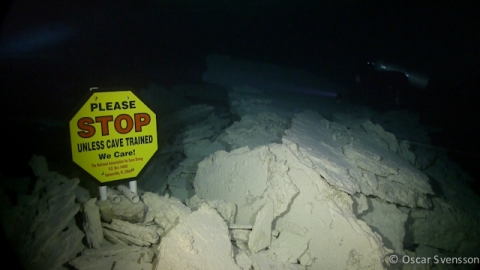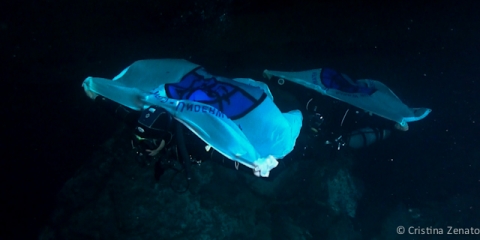It’s crystal clear in here and I am trying my best to keep it that way. One foul kick into the silt could make diving in this submerged tunnel very difficult indeed. I try a couple of small flutter kicks and make a big circle with my light to indicate that I am okay. Cristina signals back and we dive further into the labyrinth of flooded caves that honeycomb the island of Grand Bahama.
Cave diving is probably one of the single most crazy sports you can ever do. Essentially, the overhead environment means that if something were to happen you cannot (even theoretically) make a controlled emergency ascent – the recreational diver’s greatest safety factor.
So why do people like to cave dive? Why in the heavens, do so many people go to Mexico and the Bahamas to dive in enclosed, often dark space of water where there can be huge haloclines and silt up to ½ a meter high on the bottom? And yes, this is exactly what my Mum asked me when I told her of my endeavors….
The answer is that diving caves opens you up to the most unique and stunningly beautiful environment. It’s like diving into the earth’s veins according to Cave Explorer Jill Heinerth (see: We Are Water). Caves are one of the least explored environments on earth and are home to an abundance of interesting species including blind fish.
Similar to the rebreather course I did earlier this year, it’s a matter of common sense, respecting the gear and making sure that you follow important safety rules. In the words of my Instructor Cristina Zenato, cave diving doesn’t suit the crazy explorer but rather the super analytical, anally retentive, control freak. If you act like this, cave diving is almost as safe as open water diving.
I was completely stoked when Cristina Zenato, member of the Women Divers Hall of Fame, The Explorers Club, NSS-CDS Instructor and cave explorer, invited me to come and do my Cavern and Intro to Cave course in the Bahamas. One thing that really struck me about Cristina was her infectious enthusiasm for all things cave diving. “Cristina Cave Fever” was pretty much an every day occurrence involving huge smiles, high pitched squeals and lots of jumping!
Cristina taught my dive buddy, Luka Demi and I all about the caves in the Bahamas and important safety requirements. One of the most crucial things we learned were five general rules adapted from the founder of cave diving Sheck Exley:
The – Get adequate training
Good – Always run a continuous guideline to the exit
Alert – Save enough air to return safely – amount depends on level of training
Diver – Watch depth – don’t exceed the maximum operating depth of gas mix
Lives – Make sure your have adequate lighting
Learning how to lay the line around bushes – a treacherous and ominous task only meant for the select few that can handle evil prickles.
Before we could get into the cave I needed to learn how to use a backmount double cylinder configuration. This set up provides a backup regulator and cylinder to cave divers in the event that a failure should occur. I also needed to work on my buoyancy and kicking style so as not to damage the cave. Thanks to the wonderful help and tips of European Scholar Oscar Svensson, I can now complete helicopter turns, valve drills (in less then an hour!) and proper frog kicks. Importantly, I can also perform the backward fin technique without ending up in an inverted handstand. Proud as punch!
Christmas Eve and Christmas day was a fun and crazy affair in the Bahamas. Cristina did a fantastic decorating job on the Christmas tree and Oscar made tasty Pepparkakor (Swedish Ginger Cookies) in the shapes of cave diving markers. Thank you Cristina for all your lovely pressies!
With Christmas behind us, it was time to finally go cave diving! Cristina made sure to allow us plenty of time to simply familiarise ourselves with the cave environment. The first dive was not only physically demanding but also mentally challenging, as we wrestled with penetrating deeper into the confined environment and further and further from the light.
“We humans have no underwater instincts – only trained instincts,” said Cristina as we recapped the drills for the previous dive. We did share air drills and lights out scenarios, lost buddy drills – you name it if there was a drill we did it! Definitely the most challenging one was recovering the line in a lights out scenario. It made me realise that you really DO NOT want to ever get in this situation in reality. It’s extremely difficult to re find the line but the most important thing is to NEVER GIVE UP!
One of my favourite sites was Owl Hole which involved getting down a ladder with over 30 rungs of steps. It was pretty good exercise that’s for sure! I also thoroughly enjoyed diving at Bens Cavern and Mermaid Pond.
During the times that I wasn’t cave diving, Cristina let me experience the world famous Shark and Dolphin Dive at UNEXCO. Cristina is one of the few people in the world to be able to perform a unique technique called tonic immobility on sharks. By rubbing and manipulating her fingers across the ampullae of Lorenzini, the visible dots [electro-receptive sensory organs] around a shark’s head, Cristina is able to induce what looks to the observer like shark sleep. I have truly never seen anything like this before and was blown away watching Cristina handle the sharks.
The Dolphin Dive was also a really interesting experience and I’m super glad that I got to see how it works. Dolphins are kept in a large coastal enclosure and are let out for the dolphin dive. The dolphins travel on their own accord with the boats out into the open ocean where they then interact with divers for an approximately 45 min dive. The dolphins then return to their enclosure completely on their own after the dive. Many of the dolphins are past movie dolphins and I was fortunate enough to swim with Kayla and Rabala who have stared in some of the following: Zues, Roxanne and Eye of the Dolphin.
On my last day in the Bahamas I got to do a bit of photography practice with Eddy Raphael. Eddy has been in the business all his life and has shot not only underwater, but also for the fashion industry. Eddy went though the basics of capturing light – F stop, shutter speed and ISO. While it was only for a short time, I really benefited from Eddy’s help and am very grateful for his generosity.
My time in the Bahamas flew by and I was sad to see it finish. I learned so much and came out feeling like a much much better diver. Perhaps most importantly though, I made great friendships on this trip. I’ve begun to discover that it is not really the places you go but the people you meet on this Scholarship that makes the experience so special.



























